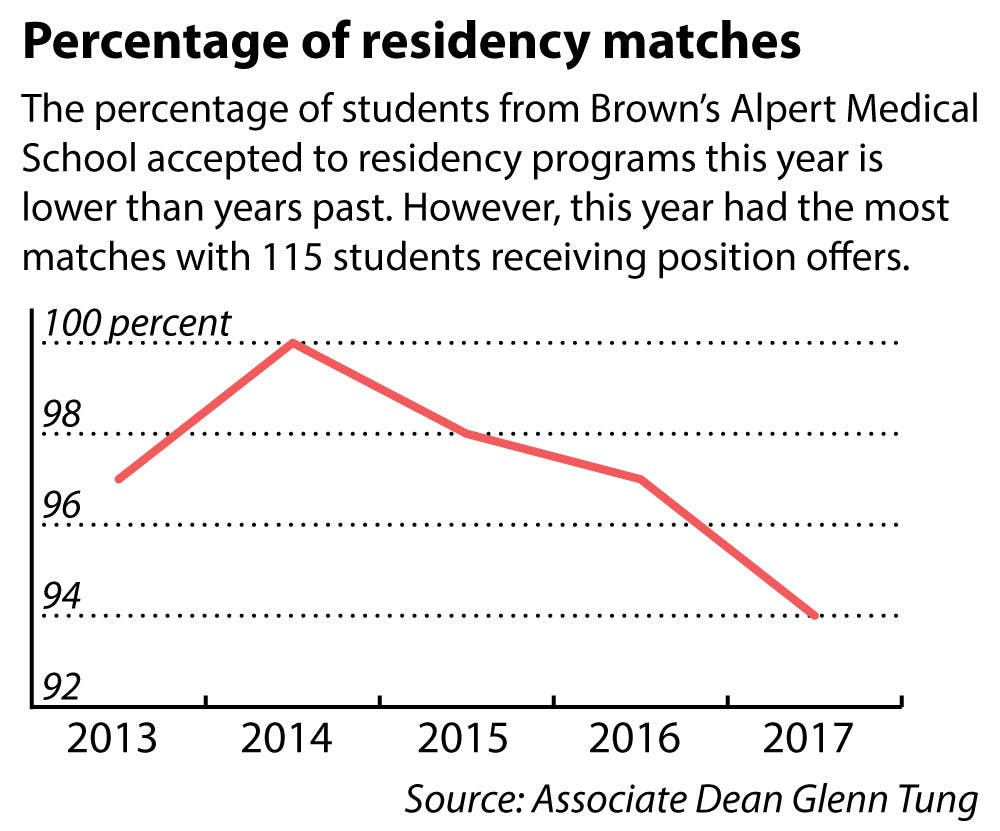On March 17, fourth-year medical students at the Alpert Medical School found out where they would begin their careers.
This year, approximately 94 percent —115 out of 122 — of fourth-year medical students were accepted into a residency program, said Associate Dean for Clinical Affairs Glenn Tung, adding that this acceptance rate is typical for the Med School.
This rate is also around the average for American medical schools, Tung said. An indicator of a good medical school is “how many of their students match into the competitive specialties,” which include orthopedics, plastic surgery, ophthalmology and radiation-oncology, he added. Of the 11 students from the Med School who applied to these competitive programs, 10 were accepted, Tung said. Overall, 47 percent of the students who matched will enter primary care programs, and 53 percent will enter specialty programs.
While the Med School’s acceptance rate has historically hovered around 95 percent, students both at the Med School and across the country have applied to an increasing number of programs in recent years, said Philip Gruppuso, professor of pediatrics, medical science and molecular biology. Gruppuso and Professor of Medical Science Eli Adashi recently published an article, titled “Residency Placement Fever: Is It Time for a Reevaluation?,” which detailed this surge in applications.
The application process — which includes online applications followed by a round of interviews — has grown to dominate a large part of students’ fourth year, Gruppuso said. Survey data from 2013 indicated that “students applying to radiation-oncology programs, on average, went to 20 interviews,” and those numbers have likely increased since then, he said.
The cost of the application process grows with the number of applications. Sending applications is easy — “you just have to check a box” — but students must pay for each program they apply to after the first 30, said Kunal Sindhu MD’17, who was accepted to a radiation-oncology program. In total, application fees and travel expenses can end up costing thousands of dollars, he added.
Sindhu applied to 89 programs in radiation-oncology and an additional 22 in medicine, as he is required to complete residencies in both areas. He ended up interviewing for 27 programs, which was “too many,” he said. Travel spanned almost two and a half months, during which “there were two weeks (when) I had interviews every single day,” he said.
Dorothy Liu MD’17 said she applied to 44 programs in general surgery. While those applications cost her $850, she knew that narrowing her focus and applying to fewer schools would be a “risky” endeavor, she said. Liu added that most students pay for the expenses incurred by the match process through additional loans.
The number of applications Med School students are submitting is on par with national averages, according to the article published by Gruppuso and Adashi. They found that, in 2015, American medical students applied to an average of 45.7 residency programs compared to 30.3 in 2005. For students interested in competitive specialities, this trend is magnified — those applying to orthopedic surgery programs submitted an average of 73 applications to a total of 163 available programs, according to the article.
The Med School provides financial support for students throughout the match process, Tung said. Fourth-year students “have provisions in their financial aid package that account for the cost of travel and lodging,” and low-income students can request extra funds from the Med School on a case-by-case basis. The Med School also asks alums to house students while they travel.
Additionally, the Med School provides important advisory help by conducting mock interviews and reviewing students’ applications, Liu said. Most students also have a faculty member who helps guide them through the process, she added.
Students have flexible schedules during the fourth year that allow them to travel to interviews, Sindhu said. There are fewer requirements during that year, and students have the option of pursuing an independent study for credit. There is a penalty for missing days of school, but “frankly, the fourth-year requirements are not very difficult, so it’s fine,” Sindhu added.
Despite the support students receive, few people at the Med School — or anywhere — have addressed the continuous increase in application volume, Gruppuso said. Students may apply to so many programs because “the current generation of students feels significantly less confident about their future prospects than (students) did 20 to30 years ago,” Gruppuso added. In reality, American medical students are just as likely to get into a residency program as they were two decades ago, but few students recognize this fact.
In the article, Gruppuso and Adashi suggested streamlining the application process by organizing interviews across all residency programs to fall on a shorter timeline and capping the number of interviews a student is allowed to attend. They also proposed conducting preliminary interviews online before selecting finalist candidates to travel. But the authors do not anticipate such changes to the process will occur soon.
Conversations about changing the matching process “is just getting started,” Gruppuso said.





